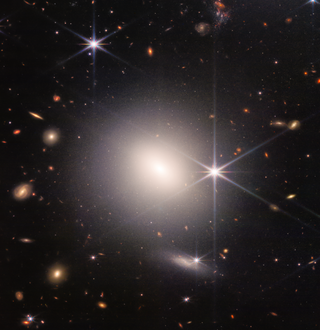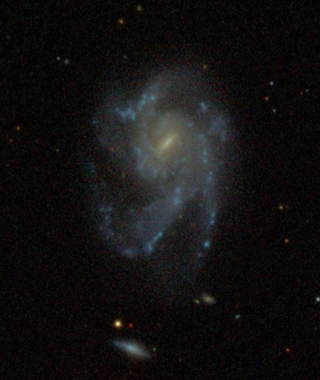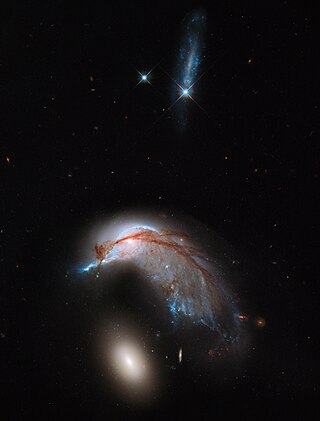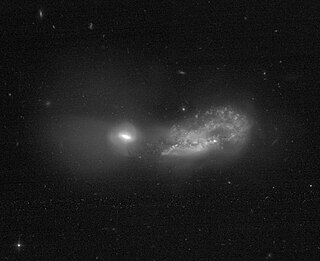
Quasars, Redshifts and Controversies is a 1987 book by Halton Arp, an astronomer famous for his Atlas of Peculiar Galaxies (1966). Arp argued that many quasars with otherwise high redshift are somehow linked to close objects such as nearby galaxies. Arp also argued that some galaxies showed unusual redshifts, and that redshifts themselves could be quantized.

Halton Christian "Chip" Arp was an American astronomer. He is remembered for his 1966 book Atlas of Peculiar Galaxies, which catalogued unusual looking galaxies and presented their images.

NGC 383 is a double radio galaxy with a quasar-like appearance located in the constellation Pisces. It is listed in Halton C. Arp's 1966 "The Arp Atlas of Peculiar Galaxies." Recent discoveries by the National Radio Astronomy Observatory in 2006 reveal that NGC 383 is being bisected by high energy relativistic jets traveling at relatively high fractions of the speed of light. The relativistic electrons in the jets are detected as synchrotron radiation in the x-ray and radio wavelengths. The focus of this intense energy is the galactic center of NGC 383. The relativistic electron jets detected as synchrotron radiation extend for several thousand parsecs and then appear to dissipate at the ends in the form of streamers or filaments.

NGC 7317 is an elliptical galaxy that is a member of Stephan's Quintet in the constellation Pegasus. Its velocity with respect to the cosmic microwave background is 6272 ± 35 km/s, which corresponds to a Hubble distance of 301.7 ± 21.2 Mly (92.51 ± 6.51 Mpc). In addition, four non-redshift measurements gives a distance of 294.27 ± 34.22 Mly (90.225 ± 10.491 Mpc).It was discovered on 27 September 1873 by French astronomer Édouard Stephan.

Arp 104, also known as Keenan's system, is entry 104 in Halton Arp's Atlas of Peculiar Galaxies catalog for spiral galaxy NGC 5216 and globular galaxy NGC 5218. The two galaxies are joined by a bridge of galactic material spanning 22 000 light years.

NGC 935 and IC 1801 are a pair of interacting galaxies within the Aries constellation. They were discovered on 18 September 1885 by Lewis Swift. NGC 935 is the northern member of the pair, and IC 1801 is the southern. Together, they are listed in Halton Arp's Atlas of Peculiar Galaxies as Arp 276, as an example of interacting galaxies.

NGC 5579 is an intermediate spiral galaxy in the northern constellation of Boötes. It was discovered on May 1, 1785) by German-British astronomer William Herschel. The galaxy is located at a distance of 179 ± 14 million light-years (54.9 ± 4.3 Mpc) from the Milky Way, and is receding with a heliocentric radial velocity of 3,608 km/s. It is entry 69 in Halton Arp's Atlas of Peculiar Galaxies.

NGC 5566 is a barred spiral galaxy in the constellation Virgo, which is approximately 66 million light years away from Earth. The galaxy is the biggest in the constellation Virgo, stretching nearly 150,000 light years in diameter. The galaxy NGC 5566 was discovered on 30 April 1786 by the German-British astronomer William Herschel. It is included in Halton Arp's Atlas of Peculiar Galaxies. It is a member of the NGC 5566 Group of galaxies, itself one of the Virgo III Groups strung out to the east of the Virgo Supercluster of galaxies.

NGC 507, also known as Arp 229, CGCG 502-67, MCG 5-4-44, PGC 5098, UGC 938, and V V 207, is a lenticular galaxy in the constellation Pisces. It was described as being "very faint", "pretty large", "round", "brighter in the middle", and "south of NGC 508" by John Dreyer in the New General Catalogue. The two galaxies are a part of the Atlas of Peculiar Galaxies, where NGC 507 is described as "Circular or near circular rings of small density difference."

NGC 3921 is an interacting galaxy in the northern constellation of Ursa Major. Estimates using redshift put it at about 59 million light years from Earth. It was discovered on 14 April 1789 by William Herschel, and was described as "pretty faint, small, round" by John Louis Emil Dreyer, the compiler of the New General Catalogue.

NGC 497 is a barred spiral galaxy approximately 336 million light-years away from Earth in the constellation of Cetus. It was discovered by French astronomer Édouard Stephan on November 6, 1882.

NGC 6040 is a spiral galaxy located about 550 million light-years away in the constellation Hercules. NGC 6040 was discovered by astronomer Édouard Stephan on June 27, 1870. NGC 6040 is interacting with the lenticular galaxy PGC 56942. As a result of this interaction, NGC 6040's southern spiral arm has been warped in the direction toward PGC 56942. NGC 6040 and PGC 56942 are both members of the Hercules Cluster.

NGC 2936, also known as the Penguin Galaxy or the Porpoise Galaxy, is an interacting spiral galaxy located at a distance of 326 million light years, in the constellation Hydra. NGC 2936 is interacting with elliptical galaxy NGC 2937, located just beneath it. They were both discovered by Albert Marth on Mar 3, 1864. To some astronomers, the galaxy looks like a penguin or a porpoise. NGC 2936, NGC 2937, and PGC 1237172 are included in the Atlas of Peculiar Galaxies as Arp 142 in the category "Galaxy triplet".

NGC 6621 is an interacting spiral galaxy in the constellation Draco. It lies at a distance of about 260 million light-years. NGC 6621 interacts with NGC 6622, with their closest approach having taken place about 100 million years ago. The pair was discovered by Edward D. Swift and Lewis A. Swift on June 2, 1885. Originally NGC 6621 was assigned to the southeast galaxy, but now it refers to the northern one. NGC 6621 and NGC 6622 are included in the Atlas of Peculiar Galaxies as Arp 81 in the category "spiral galaxies with large high surface brightness companions".

NGC 2300 is a lenticular galaxy in the constellation Cepheus. Its velocity with respect to the cosmic microwave background is 1876 ± 7 km/s, which corresponds to a Hubble distance of 90.2 ± 6.3 Mly (27.67 ± 1.94 Mpc). However, 11 non redshift measurements give a distance of 131.98 ± 21.75 Mly (40.464 ± 6.668 Mpc). The galaxy was discovered in 1871 by French astronomer Alphonse Borrelly using an 18 cm telescope.

NGC 1142 is a distorted spiral galaxy in the constellation of Cetus. It is located about 370 million light years away from Earth, which means, given its apparent dimensions, that NGC 1142 is approximately 170,000 light years across. It is a type 2 Seyfert galaxy. It interacts with the elliptical galaxy NGC 1141.

NGC 3656 is a peculiar galaxy formed by the collision of two galaxies in the constellation of Ursa Major. It is located about 135 million light years away from Earth, which means, given its apparent dimensions, that NGC 3656 is approximately 70,000 light years across. It was discovered by William Herschel on April 14, 1789.

NGC 3664 is a magellanic barred spiral galaxy in the constellation of Leo. It is located about 80 million light years away from Earth, which means, given its apparent dimensions, that NGC 3664 is approximately 50,000 light years across. It was discovered by Wilhelm Tempel on March 14, 1879. It is a member of the NGC 3640 Group of galaxies, which is a member of the Leo II Groups, a series of galaxies and galaxy clusters strung out from the right edge of the Virgo Supercluster.

NGC 3414 is a lenticular galaxy in the constellation Leo Minor. It was discovered by William Herschel on April 11, 1785. It is the central galaxy of a rich galaxy group. Two galaxies, NGC 3418 and UGC 5958, have similar redshifts and are within 800,000 light-years of NGC 3414. It is a member of the NGC 3504 Group of galaxies, which is a member of the Leo II Groups, a series of galaxies and galaxy clusters strung out from the right edge of the Virgo Supercluster.

NGC 7828 is a peculiar galaxy in the constellation Cetus. The galaxy lies about 300 million light years away from Earth, which means, given its apparent dimensions, that NGC 7828 is approximately 75,000 light years across. It was discovered by American astronomer Francis Leavenworth in 1886. NGC 7828 forms a pair with its neighbor NGC 7829. The galaxy is included in Halton Arp's Atlas of Peculiar Galaxies in the elliptical galaxies emanating material category as Arp 144.





















